StarTech Standalone Hard Drive Eraser And USB 3.0 Dock Capsule Review
by Billy Tallis on February 16, 2016 8:00 AM EST- Posted in
- Storage
- USB 3.0
- SATA
- DAS
- StarTech.com
Sequential Read Performance
The sequential read test requests blocks of 128kB and tests queue depths ranging from 1 to 32, with the queue depth doubled every three minutes for a total test duration of 18 minutes. The primary score we report is an average of the lower queue depths that are most common in client usage scenarios. We also graph how performance scales across queue depths.

The hard drive's sequential read performance is slightly lower in the dock than when connected internally, but the SSDs is slowed down to below the hard drive's speed.
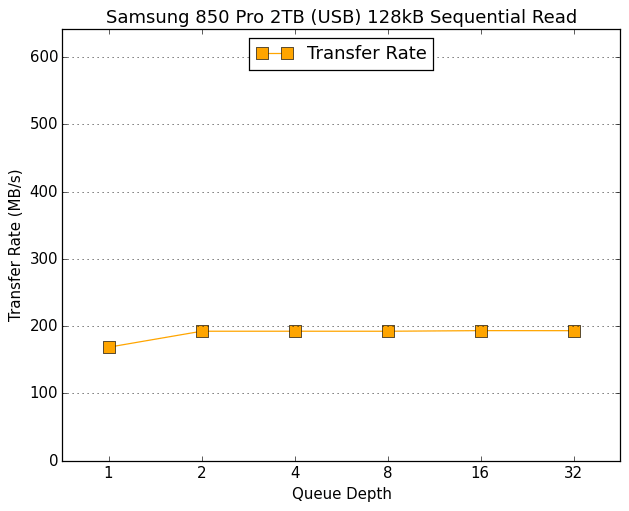 |
|||||||||
| Samsung 850 Pro 2TB (SATA) | Samsung 850 Pro 2TB (USB) | ||||||||
| Seagate Barracuda 3TB (SATA) | Seagate Barracuda 3TB (USB) | ||||||||
Both the SSD and hard drive show slightly lower QD1 performance in the dock than the very steady performance at all higher queue depths. This suggests there's a bit of command processing latency in the dock that can be masked by queuing up requests, but it's unclear why the SSDs sequential read performance ends up lower than the hard drive's.
Sequential Write Performance
The sequential write test follows the same timing and queue depth schedule as the sequential read test, and is scored the same.
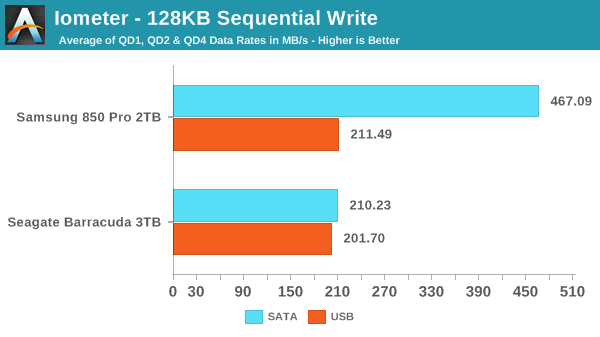
Sequential write performance is very similar to sequential read for the hard drive, with slight overhead due to the dock. The SSD manages to beat the hard drive when docked this time, but is still severely restricted by the slower interfaces.
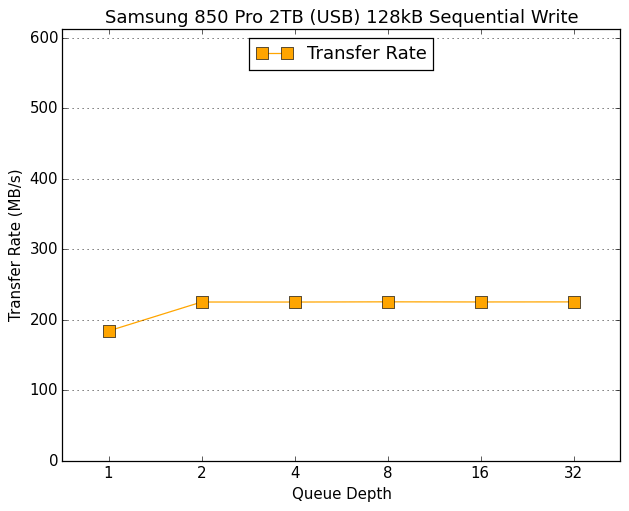 |
|||||||||
| Samsung 850 Pro 2TB (SATA) | Samsung 850 Pro 2TB (USB) | ||||||||
| Seagate Barracuda 3TB (SATA) | Seagate Barracuda 3TB (USB) | ||||||||
Again QD1 performance is slightly lower for both drives in the dock and the dock is only able to keep pace with the mechanical drive, but there are no other surprises from it on this test.
Mixed Sequential Read/Write Performance
The mixed sequential access test covers the entire span of the drive and uses a queue depth of one. It starts with a pure read test and gradually increases the proprotion of writes, finishing with pure writes. Each subtest lasts for 3 minutes, for a total test duration of 18 minutes.
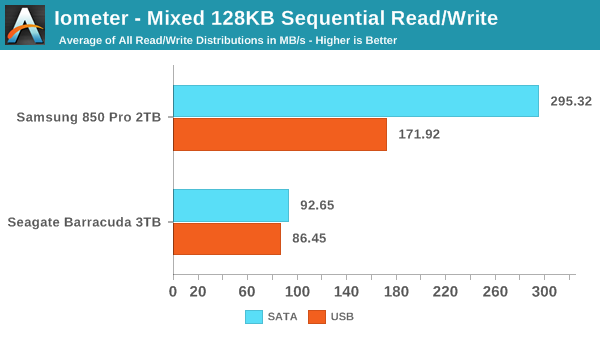
The mixed sequential test is the best showing from the dock. SSDs usually perform much worse on mixed sequential workloads than on pure read or write sequential access, so the dock's performance limits don't look as bad in this light. The hard drive's mixed sequential performance is also much worse than for pure reads or writes, and the dock's overhead is minor.
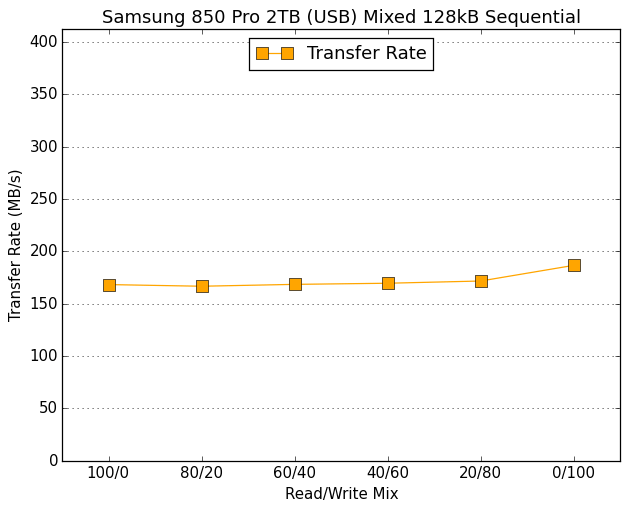 |
|||||||||
| Samsung 850 Pro 2TB (SATA) | Samsung 850 Pro 2TB (USB) | ||||||||
| Seagate Barracuda 3TB (SATA) | Seagate Barracuda 3TB (USB) | ||||||||
The dock limits the SSD to mostly-uniform performance across the mixed sequential test that is all well below what the drive can do with an internal 6Gbps SATA connection. For the hard drive, the only significant differences are moderate performance penalties on the pure-read and pure-write portions of the test.










38 Comments
View All Comments
buhusky - Tuesday, February 16, 2016 - link
I'm sorry, did I miss the part where you verified it securely erased everything or did you just take it at its word?Billy Tallis - Tuesday, February 16, 2016 - link
It depends on what you mean. When using the ATA Secure Erase mode, the dock is most definitely issuing the correct commands. What the drive does with that command is up to the drive, not the dock. Reading out the contents of the drive and checking that every byte is zero is not sufficient to verify that the drive's Secure Erase procedure actually got rid of all the data securely, because you can't read what's in spare area or remapped sectors without opening up the drive. I didn't do a full run and verification of the single-pass write zeros erase, but I did confirm that it was spending the time actually writing zeroes to the drive.Avalon - Tuesday, February 16, 2016 - link
Seems like a waste to me. If you need to be in the business of securely erasing drives, you're going to buy a multi-bay dock to get this done. My old IT company had several 8 and 16 bay duplicators/erasers on hand to process large amount of drives.If you're doing it for personal use, well, there's much cheaper ways to do this. I don't see a market for this device.
Wolfpup - Tuesday, February 16, 2016 - link
Wow, this is great! I've got one in my cart right now. I've wanted something like this for YEARS.Guess I'll plan to run the secure erase first on anything I'm getting rid of, then run the best-mode overwrite for the hell of it.
I don't really care about the performance, as long as it's doing its job. Just thrilled if I can have something simple like this to take care of such an annoying job...and I don't even need it near a computer, can plug it in anywhere with a spare outlet and let the thing run!
extide - Tuesday, February 16, 2016 - link
Page covering pop up ad!http://images.teraknor.net/popup-ad.png
xrror - Tuesday, February 16, 2016 - link
Am I the only one cackling madly at the disaster potential for this device?"oops, I guess it was in the wrong mode"
azrael- - Thursday, February 18, 2016 - link
Was just about to write pretty much the same thing.You've got to really, really, really make sure this thing is in the correct mode, because otherwise you suddenly have a lot more free space than you thought. ;-)
xrror - Friday, February 26, 2016 - link
hehe... 100% compression! ;pboozed - Tuesday, February 16, 2016 - link
Probably cheaper than buying a Mac and running Adobe CC on it too.DataMD - Wednesday, February 17, 2016 - link
Looks a handy tool for erasing small numbers of hard drives. Would be keen to understand what independent testing has been carried out to ensure all data is eradicated and whether this item has gained, or intends to gain, accreditations and government approval.